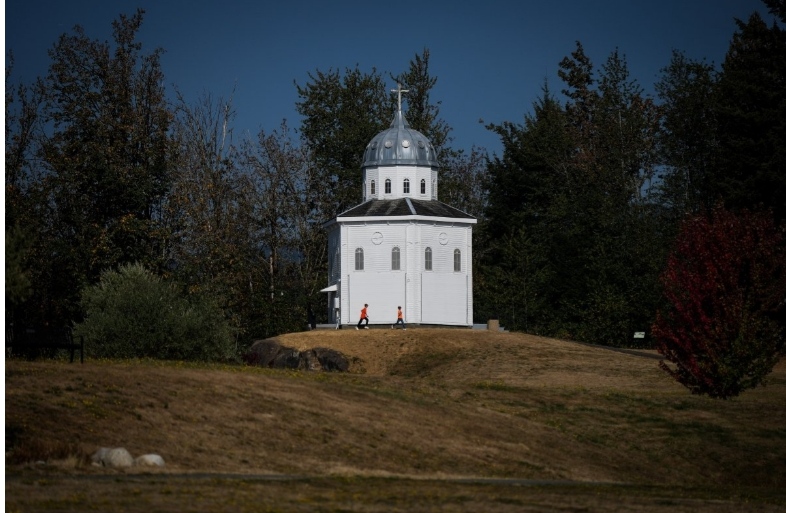First Nation in British Columbia says 158 children died at three residential school sites, hospital
By Amy Judd

Children wearing orange t-shirts run outside the Grotto that remains at the site of the former St. Mary’s Indian Residential School as a ceremony to mark the National Day for Truth and Reconciliation takes place at the bottom of the hill, in Mission, B.C., on Fri. Sept. 30, 2022
An investigation into unmarked graves and missing children by the Sto: lo Nation in British Columbia has revealed at least 158 deaths, most of them at an Indigenous hospital.
The nation’s researchers say archival documents regarding residential schools in Mission, Sardis and Yale, as well as the Coqualeetza hospital, suggest 96 children died at the hospital of diseases like tuberculosis.
Others died from accidents and some causes of death are unknown.
The investigation has spanned 18 months but officials said Thursday this is just the beginning. The nation has received about half of 70,000 possible documents, with access hampered by Ottawa and religious institutions involved in the schools.
“The heaviness can’t be summed into words,” said Sxwoyehálá Chief David Jimmie, Sto:lo Nation Chief’s Council president, in a press conference.

Lake First Nation purchases former chief residential school site
The nation’s research covers the All Hallows School in Yale, which operated between 1890 and 1917, and the Coqualeetza Industrial Institute in Sardis, about five kilometres south of Chilliwack, which ran from 1886 to 1894.
It’s also uncovering more information about St. Mary’s Indian Residential School in Mission, which lead researcher David Schaepe described as a place of punishment, starvation, abuse, intentional confinement, and child labour.
“What we learned from speaking with only a handful of survivors is devastatingly traumatic and sad,” Shaepe said.
“We heard cases of children being killed, we heard of the secretive burial of children who died, and the forced burial of children by other children.”
St. Mary’s opened in 1863. The institution of assimilation was relocated in 1882 and a new facility was built in 1933.
It closed in 1984, making it the last operating residential school in B.C. In 2004, a former employee of the school was convicted of 12 counts of indecent assault in connection with his time at the school and sentenced to three years behind bars.
“I can’t even begin to imagine what they went through, the atrocities that took place, and the impacts that we’re still feeling generations later today,” Jimmie said, referring to those forced to attend such a harrowing institution.
“We feel a fraction of what they felt.”
Project manager and researcher Amber Kostuchenko said records on the four Fraser Valley facilities came from dozens of archives at 47 different physical locations across the country.
STORY CONTINUES BELOW ADVERTISEMENT
The Sto:lo Nation’s findings are the latest of many residential school investigations that have taken place since May 2021, when Tk’emlúps te Secwépemc announced the possible remains of more than 200 children had been found at the former kamloops Indian Residential School . The news sent shockwaves of grief and anger across Canada, and forced citizens to reckon with the insidiousness of the country’s colonial past.
Other First Nations searching their own former residential school sites with ground-penetrating radar have now revealed more than 2,000 possible burial sites from coast to coast.
“This is another opportunity for educating and ensuring the general public — not only in our province, in our country — but across the world, understands what took place here in Canada, understands the work that still needs to happen for us to support those (survivors),” Jimmie said.

Between the 1800s and mid-1990s, Canada’s residential school system aimed to “eliminate parental involvement in the intellectual, cultural and spiritual development” of Indigenous children, according to theTruth and Reconciliation Commission ..
The state- and church-run institutions removed more than 150,000 First Nations, Métis and Inuit children from their families and imprisoned them in schools where many were physically, sexually and spiritually abused. Some were starved as part of scientific experiments on the effects of malnutrition. Many became ill with smallpox, measles, influenza, tuberculosis and other unknown illnesses due to lack of proper care.
Thousands died and many parents were never told what happened to their children. The system of assimilation created intergenerational trauma that has had a deep and lasting impact on survivors, their children, relations and communities.
To this day, governments have failed in many ways to meaningfully repair or compensate for what Pope Francis has now affirmed was a genocide .
— With files from Janet Brown, Elizabeth McSheffrey and The Canadian Press




